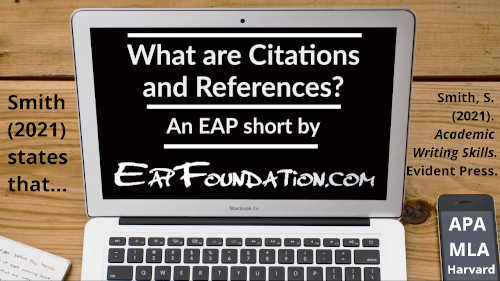Show AWL words on this page.
Show sorted lists of these words.


 







|
In academic writing, you will need to cite (or 'refer to') other people's work or ideas. This section considers how to do this by first looking at what references and citations are, then answering the question of why you need to cite.
What are references & citations?
The terms reference and citation are important in academic writing and the difference between the two can be confusing (though in fact understanding the difference is less important than being able to use both correctly!). The following distinctions are standard in academic writing.
- Citation: a specific source used in your text; also called in-text citation, as it occurs in the main body of the text. It can be considered to be short-hand format, as it does not contain full text (or 'biographical') information.
- Reference: the full text (or 'biographical') details, such as publisher or URL, title, etc.; also called end-text citation or work cited. It is contained in the Reference Section at the end of the work. The reference allows the reader to find the text easily, and is the long-hand format of the in-text citation.
Why cite?
The answer to the question of 'Why cite?' is to maintain appropriate academic standards and honesty. You will need to use other people's ideas or words in your writing to make it stronger, and when you do this it is appropriate to acknowledge the fact that these are not your own ideas or words. This is done via citations. It is also appropriate to allow the reader to locate the source and verify the information, and this is done via the references.
A shorter (and more common, though in some ways incorrect) answer to the question of 'Why cite?' is 'to avoid plagiarism'. This is discussed more below in the section on avoiding plagiarism, which also gives types of plagiarism and reasons why students plagiarise.
References
Bailey, S. (2000). Academic Writing. Abingdon: RoutledgeFalmer
Cornell University (2005) What is the difference between documentation, citation, and reference? Available at: https://plagiarism.arts.cornell.edu/tutorial/logistics3.cfm (Access date: 10/11/15).
Pears, R. and Shields, G. (2013). Cite them right: The essential guide to referencing. 9th edn. Basingstoke: Palgrave MacMillan.
Next section
Find out about in-text citations in the next section.
Previous section
Go back to the previous section about evaluating sources.






